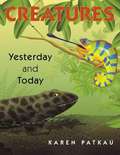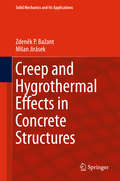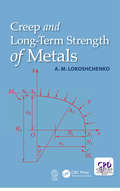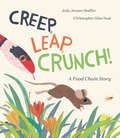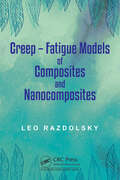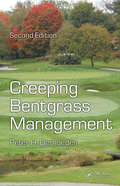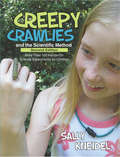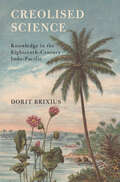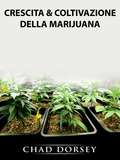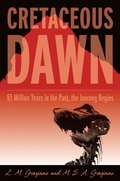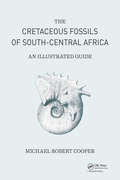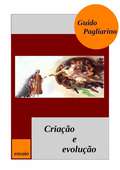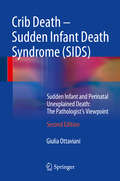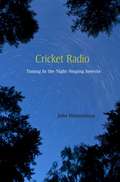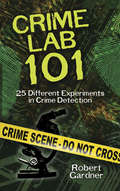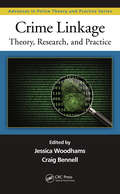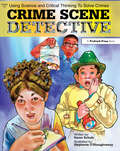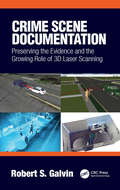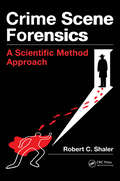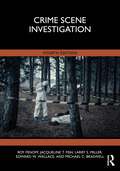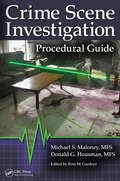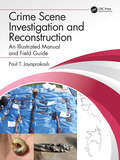- Table View
- List View
Creatures of Cain: The Hunt for Human Nature in Cold War America
by Erika Lorraine MilamHow Cold War America came to attribute human evolutionary success to our species' unique capacity for murderAfter World War II, the question of how to define a universal human nature took on new urgency. Creatures of Cain charts the rise and precipitous fall in Cold War America of a theory that attributed man’s evolutionary success to his unique capacity for murder.Drawing on a wealth of archival materials and in-depth interviews, Erika Lorraine Milam reveals how the scientists who advanced this “killer ape” theory capitalized on an expanding postwar market in intellectual paperbacks and widespread faith in the power of science to solve humanity’s problems, even to answer the most fundamental questions of human identity. The killer ape theory spread quickly from colloquial science publications to late-night television, classrooms, political debates, and Hollywood films. Behind the scenes, however, scientists were sharply divided, their disagreements centering squarely on questions of race and gender. Then, in the 1970s, the theory unraveled altogether when primatologists discovered that chimpanzees also kill members of their own species. While the discovery brought an end to definitions of human exceptionalism delineated by violence, Milam shows how some evolutionists began to argue for a shared chimpanzee-human history of aggression even as other scientists discredited such theories as sloppy popularizations.A wide-ranging account of a compelling episode in American science, Creatures of Cain argues that the legacy of the killer ape persists today in the conviction that science can resolve the essential dilemmas of human nature.
Creatures: Yesterday and Today
by Karen PatkauFrom the worlds of insects, fish, mammals, sea jellies, reptiles, amphibians, birds, crustaceans, arachnids, and mollusks, she presents living animals and their prehistoric ancestors. Meet Diplodocus and Skylark; Cameroceras and Blue-Ringed Octopus; Brontoscorpio and Fat-Tailed Scorpio; and learn what links them across the ages.
Creep and Hygrothermal Effects in Concrete Structures (Solid Mechanics and Its Applications #225)
by Zdeněk P. Bažant Milan JirásekThis comprehensive treatise covers in detail practical methods of analysis as well as advanced mathematical models for structures highly sensitive to creep and shrinkage. Effective computational algorithms for century-long creep effects in structures, moisture diffusion and high temperature effects are presented. The main design codes and recommendations (including RILEM B3 and B4) are critically compared. Statistical uncertainty of century-long predictions is analyzed and its reduction by extrapolation is discussed, with emphasis on updating based on short-time tests and on long-term measurements on existing structures. Testing methods and the statistics of large randomly collected databases are critically appraised and improvements of predictions of multi-decade relaxation of prestressing steel, cyclic creep in bridges, cracking damage, etc. , are demonstrated. Important research directions, such as nanomechanical and probabilistic modeling, are identified, and the need for s eparating the long-lasting autogenous shrinkage of modern concretes from the creep and drying shrinkage data and introducing it into practical prediction models is emphasized. All the results are derived mathematically and justified as much as possible by extensive test data. The theoretical background in linear viscoelasticity with aging is covered in detail. The didactic style makes the book suitable as a textbook. Everything is properly explained, step by step, with a wealth of application examples as well as simple illustrations of the basic phenomena which could alternate as homeworks or exams. The book is of interest to practicing engineers, researchers, educators and graduate students.
Creep and Long-Term Strength of Metals
by A. M. LokoshchenkoCreep and Creep Rupture of Metals is devoted to the fundamental description of the phenomenon of creep which occurs widely in high-temperature deformation of metals. Special attention is paid to the analysis of long-term strength, which characterizes the stress at which the metal does not fail after a predetermined time. The author details experimental and theoretical results obtained by Soviet and Russian scientists that are absent in currently available publications and demonstrates analytical methods and approaches to achieve long term strength in Metals.
Creep, Leap, Crunch! A Food Chain Story
by Jody Jensen ShafferIn this nonfiction picture book, discover how the animal kindgdom's food chain takes shape, from the lowly worm to the mighty king of the jungle.There was a blue sky with a bright shining sun,A dazzling, life-giving, fiery sun.The day had begun. Follow along as a day in the life of the food chain begins. From the sun that shines upon the grass and trees to the animals that feed each other, each element in nature has its place. But what happens when the food escapes? This cumulative story will delight, with a surprise ending that all science lovers will enjoy.
Creep: Fatigue Models of Composites and Nanocomposites
by Leo RazdolskyIn recent years, the application of composites and nanocomposites has been increasing steadily in industries such as aerospace, automotive, marine, and civil engineering. It is among the most complex and crucial aspects of the mechanics of a deformable solid, due to several specific phenomena and analytic factors arising from cyclic loading. The problems are primarily associated with the development of fatigue damage, and the need to assess the cyclic and structural instability of composite and nanocomposite materials. The study of structural strength under cyclic loading has gained much attention, especially in aircraft manufacturing, power engineering, aviation, and rocket technology. Cyclic loading significantly reduces creep-fatigue lifespan during the entire frequency range. It is clear that characteristics such as endurance limit, static creep limits and long-term static strength will not suffice in the design criteria for fatigue life. New aspects have emerged in high-temperature strength - cyclical creep and long-term cyclic strength, leading to the creation of new methods and means of determining the resistance of composites and nanocomposites materials and continuum damage development under cyclic loading to the creation of appropriate physical models. Particularly relevant is the intensification of creep by high-frequency cyclic loading in composite materials, which usually occurs at high temperatures. Most studies in the field of cyclic creep are experimental, and the direct use of number of cycles to define damage model cannot escape the empirical relation that predicts multi-stress level fatigue life well. The book presents new phenomenological cyclic creep – fatigue models for describing the fatigue life and behavior of time-dependent composites and nanocomposites. Since the main difference between the creep process from the fatigue process is that from a physical point of view, the first is quasi-static, and the second is dynamic. Therefore, the functions of creep should reflect the oscillatory nature of the fatigue process. The results are supported by step-by-step practical design examples and will be useful for practicing structural engineers, code developers as well as research and university faculty.
Creeping Bentgrass Management
by Peter H. DernoedenCreeping bentgrass is considered the premier turfgrass species grown on golf courses, and there is a growing demand for an understanding of its maintenance and management practices. Still the only comprehensive reference on the subject, Creeping Bentgrass Management, Second Edition helps you identify the factors that contribute to summer bentgrass
Creepy Crawlies and the Scientific Method
by Sally KneidelFrom monarch butterflies to hissing cockroaches, Creepy Crawlies and the Scientific Method, Second Edition shows teachers and parents how to use bugs, insects and critters to teach children the five steps of the scientific method: question, hypothesis, methods, result, and conclusion. Focusing on fun as well as education, and operating on the premise that doing is learning, Creepy Crawlies offers more than 100 different activities which will ignite children's curiosity while also building foundations for critical thinking and scientific understanding. This classroom-tested collection of experiments is a perfect resource for teachers or just an afternoon of educational fun at home. The second edition includes updated content and four new insect species: the monarch butterfly, the black swallowtail butterfly, the bessbug, and the Madagascar hissing roach!Sally Kneidel, PhD, grew up next to a small creek and experienced crawling creatures at an early age. Her interest led her to ultimately pursue a PhD in biology from the University of North Carolina-Chapel Hill. Kneidel has now taught for more than fifteen years, including college biology courses and writing classes. She writes on a variety of science topics, ranging from health to wildlife conservation, has published numerous other books, and has won several awards for writing, blogging, and photography. The first edition of this book, and the sequel to it, were both named in Science Books & Films' "Best Books for Children" list.
Creolised Science: Knowledge in the Eighteenth-Century Indo-Pacific (Science in History)
by Dorit BrixiusThis rich, deeply researched study offers the first comprehensive exploration of cross-cultural plant knowledge in eighteenth-century Mauritius. Using the concept of creolisation – the process by which elements of different cultures are brought together to create entangled and evolving new entities – Brixius examines the production of knowledge on an island without long-established traditions of botany as understood by Europeans. Once foreign plants and knowledge arrived in Mauritius, they were adapted to new environmental circumstances and a new socio-cultural space. Brixius explores how French colonists, settlers, mediators, labourers and enslaved people experienced and shaped the island's botanical past, centring the contributions of subaltern actors. By foregrounding neglected non-European actors from both Africa and Asia, within a melting pot of cultivation traditions from around the world, she presents a truly global history of botanical knowledge.
Crescita & Coltivazione della Marijuana
by Hiddenstuff EntertainmentIl manuale definitivo e passo a passo per far crescere e coltivare la marijuana. Impara come far crescere la cannabis con passi facili da seguire dall'inizio alla fine. Impara ed inizia a far crescere in poche ore. Istruzioni semplici e facili da seguire. Utilizzando le strategie di crescita più efficaci puoi far crescere le tue piante come fanno i professionisti. Qui i contentuti: -Progetta la tua area per la coltivazione -Illuminazione -Aerazione -Come monitorare la crescita delle piante -Tipologie di ambienti per la crescita -Contenitori -Nutrienti -Innaffiare le piante Risparmia tempo e denaro utilizzando questo manuale definitivo. --> Vai all'inizio della pagina e clicca su aggiungi al carrello per comprarlo immediatamente Disclaimer: This author and or rights owner(s) make no claims, promises, or guarantees about the accuracy, completeness, or adequacy of the contents of this book, and expressly disclaims liability for errors and omissions in the contents within. This product is for reference use only.
Cretaceous Dawn
by Michael S. Graziano Lisa M. Graziano"...An adventure-filled journey... In spite of its references to hard academic science, Cretaceous Dawn is a first-class adventure story, an effortless read as engaging as vintage Jules Verne. The descriptive prose is both evocative and illuminating, and the plot has enough twists and cliffhangers to keep readers traveling on to the inevitable conclusion."--Natural History "The Grazianos, sibling scientists, combine speculation and science in a compulsively page-turning time-travel adventure. A physics experiment gone awry sends four people and a dog 65 million years into the past. Day-to-day survival among creatures like giant croc Deinosuchus and T. rex becomes a priority, even as the group of stranded scientists realizes that getting home involves a 1,000 mile trek across the amazing landscape of Hell Creek. Details about plants, animals and insects in the distant past set the stage for a tight, scientifically plausible plot with a wholly unexpected twist that will keep readers guessing."--Publishers Weekly A long-extinct beetle appears in a physics lab. Four-and-a-half people and a dog are hurled 65 million years through time, to the Age of the Dinosaurs, and paleontologist Julian Whitney and his companions have only one chance for rescue. Meanwhile in the lab, police chief Sharon Earles must solve the mystery of why half a body remains where five people had just been. Physicists try to determine what went wrong but can they fix the vault in time to retrieve the missing people--and do they want to? "A rip-snorting good yarn. . . . Cretaceous Dawn's strength is its ability to transport the reader back in time to truly experience the Cretaceous."--Dinosaur News "Rendered with a clarity and vividness that gives the novel its richness, Cretaceous Dawn is plain fun, and educational at that. Short of time travel, this is as close as you'll ever get to the grim, predatory world of the Cretaceous."--Falmouth Enterprise "From the Inland Sea to the infant Rocky Mountains, we see the entirety of a long-gone ecosystem. The authors' scientific knowledge gives the story, and the giant creatures it is centered around, a realism that is immensely entertaining."--Prehistoric Times "[The era is] described so vividly the reader forgets that no human overlapped with a dinosaur in the sands of time."--The Cape Cod Chronicle Lisa M. Graziano, PhD, is a freelance editor and writer living on Cape Cod, Mass. She spent ten years as a professor of oceanography in Woods Hole, Mass. before turning to a full-time writing career. Michael S. A. Graziano, PhD, is a neuroscientist at Princeton University. He is the author of both fiction and nonfiction.
Cretaceous Fossils of South-Central Africa: An Illustrated Guide
by Michael Robert CooperThis book serves as an introduction to the Cretaceous geology and palaeontology of south-central Africa, covering the whole of Southern and Eastern Africa and Angola. Fifty two plates illustrate almost 1000 species and provide a field guide to the macrofossils of the subcontinent. The book will be of value to field geologists, students and non-specialists with an interest in the natural world. A bibliography of the Cretaceous palaeontology and stratigraphy of the subcontinent is provided. Features: Provides a concise account of the Cretaceous geology for 13 African regions Includes beautiful illustrations and a comprehensive bibliography Fossils are presented in stratigraphical order, allowing easy determination of the age deposits.
Criação e evolução
by Guido Pagliarino Verônica SantosCriação e evolução por Guido Pagliarino O ensaio trata de temas ligados ao evolucionismo, sobre o qual aumenta o preconceito e as imprecisões, como a ideia de que os termos "evolucionismo" e "darwinismo" sejam sinônimos, enquanto as teorias evolucionistas são múltiplas. O autor também trata do significado do termo acaso, mostra que na base da pesquisa científica existe sempre uma posição filosófica e às vezes também teológica ou até mesmo, profundamente ideológica. Considera as argumentações do criacionismo que, aos de fora de certos círculos fundamentalistas, não se baseiam em citações bíblicas, mas envolvem considerações racionais. Retornando ao evolucionismo e em particular à teoria dos equilíbrios pontuados, combatida ao que parece pelos criacionistas e vista com simpatia pelos evolucionistas religiosos ou não. Apresenta o pensamento dos últimos Papas sobre a evolução.
Crib Death - Sudden Infant Death Syndrome (SIDS): Sudden Infant and Perinatal Unexplained Death: The Pathologist's Viewpoint
by Giulia OttavianiCrib death or sudden infant death syndrome is the most frequent death-causing syndrome during the first year of life, striking one infant in every 700-1,000. Despite a wide spectrum of theories and years of research, crib death remains a great enigma. This book describes systematic studies of the cardiovascular system and autonomic nervous system carried out in a large number of infants, newborns, and fetuses who have died suddenly and unexpectedly, as well as in age-matched control cases. The cardiovascular and neuropathological findings are presented in detail and the relationship between crib death and unexplained perinatal death is discussed. This monograph will aid pathologists, forensic pathologists, pediatricians, obstetricians and neonatologists in recognizing all potential morphological substrata. It puts forward a well-researched standardized postmortem protocol to be applied in all cases of sudden unexpected infant and perinatal death.
Cricket Radio: Tuning in the Night-Singing Insects
by John HimmelmanAt a time when night-singing insects have slipped beyond our notice—indeed, are more likely to be heard as NatureSounds than in a backyard—John Himmelman seeks to reconnect us to creatures whose songs form a part of our own natural history. On warm summer evenings, night-singing insects produce a whirring, chirping soundscape—a calming aural tapestry celebrated by poets and naturalists for millennia. But “cricket radio” is not broadcast for the easy-listening pleasure of humans. The nocturnal songs of insects are lures and warnings, full of risks and rewards for these tiny competitive performers. What moves crickets and katydids to sing, how they produce their distinctive sounds, how they hear the songs of others, and how they vary cadence, volume, and pitch to attract potential mates, warn off competitors, and evade predators is part of the engaging story Cricket Radio tells. Himmelman’s narrative weaves together his personal experiences as an amateur naturalist in search of crickets and katydids with the stories of scientists who study these insects professionally. He also offers instructions for bringing a few of the little singers into our homes and gardens. We can, Himmelman suggests, be reawakened to these night songs that have meant so much to the human psyche. The online insect calls that accompany this colorfully illustrated narrative provide a bridge of sound to our past and to our vital connection with other species.
Crime Lab 101: 25 Different Experiments in Crime Detection (Dover Children's Science Books)
by Robert GardnerDo you have what it takes to be a crime scene investigator? Any budding detective with an interest in police work will be fascinated by this inside look at detection and forensic science. A series of Crime Labs focus on practicing specific techniques, and Crime Lab Exercises explore the principles behind the methods of detection. Learn how to record and lift fingerprints, identify a ransom note's ink, and reveal messages on a seemingly blank page. You'll also discover approaches to code cracking; voice pattern analysis; and matching hair, clothing, and tissue samples. A history of forensic science is included in this eye-opening look at crime detection, along with true-life tales of famous sleuths and remarkable cases."An entertaining title for junior detectives, recreational readers, and science-fair students." -- School Library Journal"Detective wannabes will find a wealth of how-to tips." -- New York Newsday
Crime Linkage: Theory, Research, and Practice (Advances in Police Theory and Practice)
by Jessica Woodhams Craig BennellThe increasing portrayal of forensic investigative techniques in the popular media CSI, for example, has resulted in criminals becoming "forensically aware" and more careful about leaving behind physical evidence at a crime scene. This presents law enforcement with a significant problem: how can they detect serial offenders if they cannot rely on p
Crime Prevention: International Perspectives, Issues, and Trends
by John A. WinterdykThis text presents an international approach to the study of crime prevention. It offers an expansive overview of crime prevention initiatives and how they are applied across a wide range of themes and infractions, from conventional to non-conventional forms of crime. Based on a review of the literature, this is the first text to offer a broad, yet comprehensive, examination of how and why crime prevention has gained considerable traction as an alternative to conventional criminal justice practices of crime control in developed countries, and to provide a cross-sectional view of how crime prevention has been applied and how effective such initiatives have been. Crime Prevention: International Perspectives, Issues, and Trends is suitable for undergraduate students in criminology and criminal justice programs, as well as for graduates and undergraduates in special topics courses.
Crime Prevention: Theory and Practice, Second Edition
by Stephen SchneiderIn Crime Prevention: Theory and Practice, Second Edition, Dr. Schneider has updated every chapter in this reliable text using the latest research, the most recently published articles and books, and feedback from professors and students using the first edition. Providing an introduction to dominant approaches, key concepts, theories, and research,
Crime Scene Detective: Using Science and Critical Thinking to Solve Crimes (Grades 5-8)
by Karen K. SchulzWatch the excitement ripple through your classroom as students use their intellect to find out who committed the "crime" at your school. Enliven your students as they practice critical thinking skills. Students are often taught skills such as the scientific method, scientific research, critical thinking, making observations, analyzing facts, and drawing conclusions in isolation. Studying forensic science allows students to practice these skills and see theories put into practice by using circumstances that model real-life events, meanwhile letting students explore a variety of career options.This exciting unit includes: background information on forensics, exploration of careers in forensic science and law enforcement, a simulation involving a fire in the school library, and instructions for writing your own crime scene simulation. To crack the case, students examine evidence left at the scene, interview suspects (staff members), and use critical thinking to connect all of the clues and eliminate suspects. Students will feel like real investigators with this true-to-life simulation.Let your students solve more mysteries with Mystery Disease, Mystery Science, Detective Club, and The Great Chocolate Caper.Grades 5-8
Crime Scene Documentation: Preserving the Evidence and the Growing Role of 3D Laser Scanning
by Robert S GalvinWhen a criminal act or vehicle crash occurs, most often a local law enforcement agency responds and is responsible for both investigating the scene and for documenting it. It is critical that scene evidence is collected and recorded efficiently, as the scene can quickly change. The sooner evidence can be collected, reviewed, and analyzed, the better an understanding investigators will have as to how and why the incident occurred. Crime Scene Documentation: Preserving the evidence and the growing role of 3D laser scanning demonstrates at length the value of laser scanning through the use of numerous case studies of investigators who have utilized various 3D technologies and laser scanning to document scenes. Thorough and accurate scene documentation is an essential function at a science and proves particularly valuable in courtroom presentations to help jurors understand a crime or accident’s likely chain of events. The more advanced a scene documentation method is, the better it can be utilized to capture details that will lead to optimal scene diagramming. Currently, 3D laser scanning is the most advanced method of scene documentation available, capturing detailed and realistic digital scans—capturing scenes in their entirety—and yielding a permanent representation of the scene for study and analysis at any time, even years after a crime scene has vanished. The book explains current technology, the latest advances, and how to best utilize the technology. Case examples come from various applications, from tools to programs, can help crash scene investigators understand how scanning can improve scene documentation, provide better and more evidence details, and build more credible diagrams that possibly may be used in court presentations to help support a case. Key Features: Describes 3Dscene recording methods in use and how well they work Outlines the variables and inherent challenges associated with documenting crime and crash scenes Illustrates the positive, and dramatic, impact of having a well-documented scene, particularly in the courtroom Explores how 3D laser scanning has vastly changed the way and extent to which crime and crash scenes can be captured accurately and completely, and subsequently analyzed Explains how laser scanning is highly flexible and presents strategies to integrate it into other crime scene incident recording techniques and technologies Crime Scene Documentation details the many benefits of 3D laser scanning technology relative to its reliability and accuracy as well as the multiple case scenarios in which it can be used. The book serves as an invaluable resource to crime scene technicians, investigators, and reconstructionists on the best ways to document a crime or crash scene.
Crime Scene Forensics: A Scientific Method Approach
by Robert C ShalerBridging the gap between practical crime scene investigation and scientific theory, Crime Scene Forensics: A Scientific Method Approach maintains that crime scene investigations are intensely intellectual exercises that marry scientific and investigative processes. Success in this field requires experience, creative thinking, logic, and the correct
Crime Scene Investigation
by Larry S. Miller Michael C. Braswell Jacqueline T. Fish Edward W. Wallace Roy FenoffCrime Scene Investigation offers an innovative approach to learning about crime scene investigation, taking the reader from the first response on the crime scene to documenting crime scene evidence and preparing evidence for courtroom presentation. It includes topics not normally covered in other texts, such as forensic anthropology and pathology, entomology, arson and explosives, and the electronic crime scene. Numerous photographs and illustrations complement text material, and a chapter-by-chapter fictional narrative also provides the reader with a qualitative dimension of the crime scene experience.
Crime Scene Investigation Procedural Guide
by Ross M. Gardner Michael S. Maloney Donald HousmanThose tasked with investigating crime scenes come from a variety of backgrounds and varying levels of experience. Crime Scene Investigation Procedural Guide gives the novice investigator the procedures for almost any crime scene imaginable while providing the seasoned pro a ready reference for crimes occurring even under the most unusual of circums
Crime Scene Investigation and Reconstruction: An Illustrated Manual and Field Guide
by Paul T. JayaprakashCrime Scene Investigation and Reconstruction: An Illustrated Manual and Field Guide provides methodologies to help investigators to think broadly when seeking out evidence at a scene and, likewise, utilize all the information from a case—especially the observable physical evidence, besides what are collectable, in reconstructing events. In the introductory chapters the author highlights the importance of crime scene reconstruction when answering the question “How something could have happened?” From there, he goes on to explain the principles of exchange, identification, individualization and reconstruction. Here, the “observe-hypothesize” model, proposed in this field-guide, is presented: outlining how every source of information ranging from laboratory reports, opinions from medical doctors, statements of witnesses, and confessions of suspects should be reconcilable with the evidence-based reconstruction made in the crime scene. In this, the author contends that qualified crime scene generalists are the ideal professionals to frame scientific hypothesis and to make reconstructions. Practical recommendations, based on best-practice general crime scene procedures are provided while the second half of the book illustrate and outline how to deal with various types of major crime scenes, including fire deaths, exhuming buried human remains, sexual assaults, death by electrocution, explosion, drowning, poisoning, hanging, and more. Since a picture is a worth thousand words, over 400 collective photographs and sketches are included throughout the book to illustrate the observational methods that are described. In addition, the field-guide provides several easy-to-follow flow-charts to serve as checklists to aid scene investigation in major types of crime scene. In this, Crime Scene Investigation and Reconstruction: An Illustrated Manual and Field Guide will help investigators readily recognize similar manifestations in crime scenes and to apply and use such techniques appropriately in their own work.

